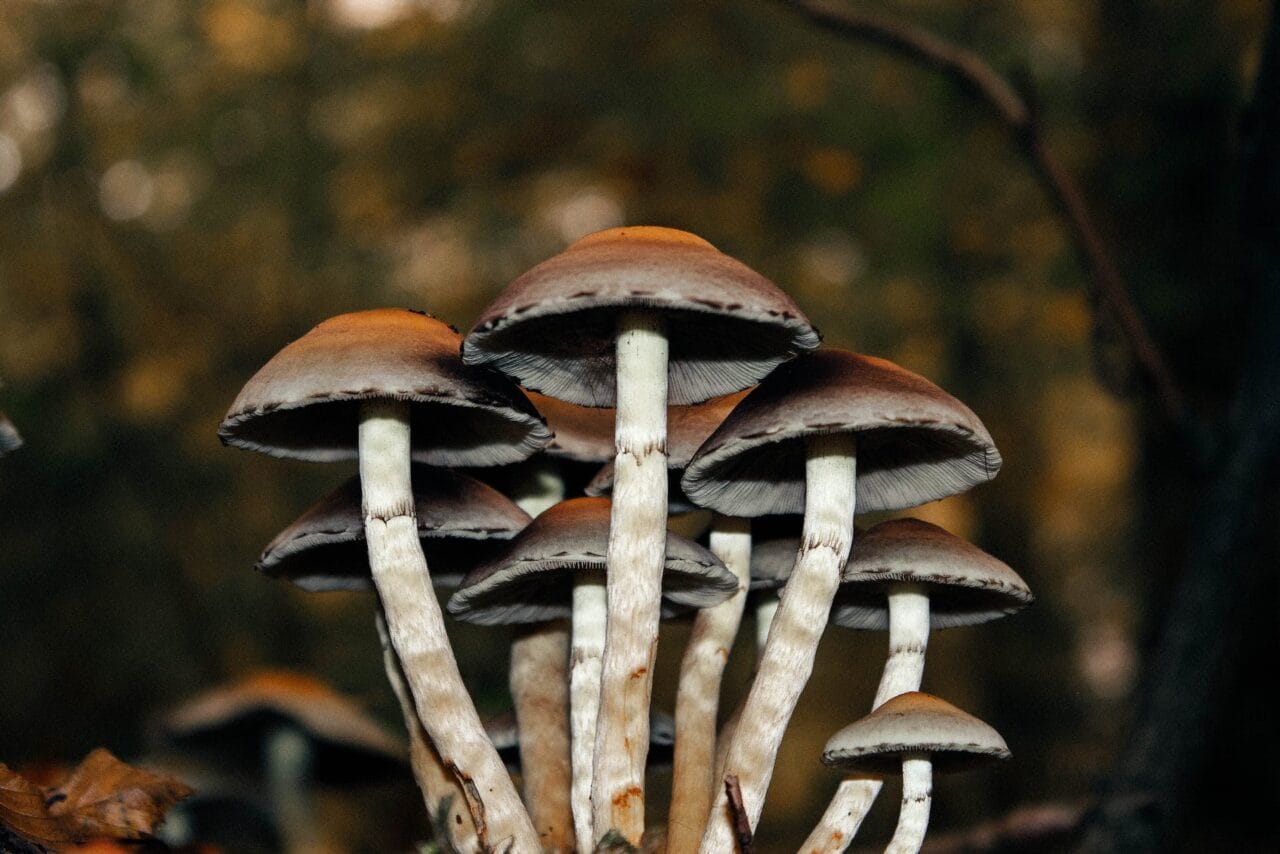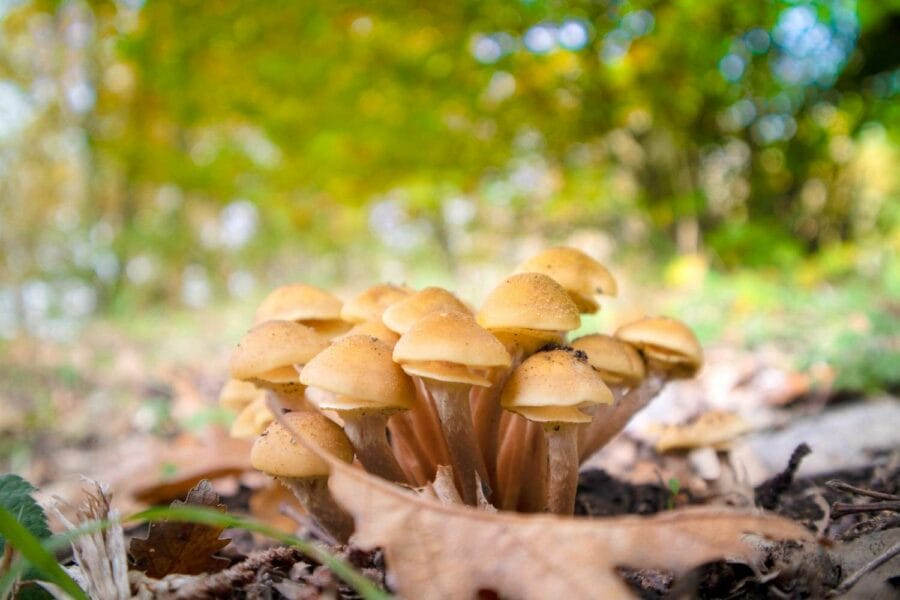Psilocybin, a psychoactive compound found in magic mushrooms, is often used recreationally for its euphoric effects and ability to induce hallucinations.
Aside from its cognitive altering properties, the compound has been studied for its potential to provide relief from chronic pain.
This article delves into a case study that investigates the potential of microdosing mushrooms in alleviating chronic pain.
Key Takeaways:
- Microdosing mushrooms could potentially provide both immediate and sustained pain relief.
- Psilocybin microdosing typically has fewer side effects compared to traditional pain medications, especially when administered in minute quantities.
- Psilocybin interacts with serotonin 2A (5-HT2A) receptors, which may help alleviate pain among other conditions.

The Study
The research, “Microdosing Psilocybin for Chronic Pain: A Case Series,” was carried out by Dr. Matthew Lyes and his team from the Division of Pain Medicine in the Department of Anesthesiology at the University of California, San Diego. The study focused on three patients who self-administered small doses of psilocybin to manage their chronic pain.
Three Patients, One Result – Chronic Pain Reduction
Patient # 1
| AGE/ GENDER: | 37 Male |
| TYPE OF PAIN: | Neuropathic pain occurring below the site of a spinal cord injury. |
| PAIN LEVEL: | Initially 4 to 5 out of 10, increasing to 8 out of 10 later in the day |
| PSILOCYBIN DOSE: | 250 mg of ground mushroom for under 6 months |
| RESULT: | Discontinuation of prescribed pain medication, reduction in muscle spasms, and improved bowel movement efficiency. No signs of rebound pain or withdrawal symptoms. |
| The patient reported that, unlike his regular medications which only managed to dull the pain, psilocybin effectively eliminated it, reducing his average pain level from 5 to 0. | |
Case Study: Subject #2
| AGE/ SEX: | 69-year-old female |
| PAIN TYPE: | Complex Regional Pain Syndrome (CRPS) |
| PAIN INTENSITY: | Regularly fluctuates between 5 and 7 out of 10, but increases with physical activity and during pain outbreak |
| PSILOCYBIN DOSE: | Consumption of 500 mg daily for periods of 7 to 10 days with 2 to 3 days of rest over a year. Dosage is increased to 750 mg to 1 gram during pain outbreaks |
| EFFECT: | Reduces pain by 80% for 3-4 hours, with pain levels gradually returning to original levels after 12 hours. Full pain relief (90%-100%) lasts for 6-8 hours, with pain returning to original levels after 18 hours. |
| The subject reported a decrease in appetite without feelings of nausea. She experiences disorientation or instability in walking when the dosage is increased (750 to 1000mg). | |
Case Study: Subject # 3
| AGE/ SEX: | 40-year-old female |
| PAIN TYPE: | Lumbar radiculopathy and neuropathic pain |
| PAIN INTENSITY: | 8 out of 10, increasing to 10 out of 10 during physical activity |
| PSILOCYBIN DOSE: | 1000 mg from a mushroom chocolate bar every two months. |
| EFFECT: | Significant pain relief without any psychoactive effects. An increase in flexibility and functionality was noted. Pain gradually returns to original levels over a period of 2-4 weeks. Recurring dosage leads to better pain control. |
| The subject reports no significant physical, cognitive, or behavioural side effects. Her mood remains stable. She continues her regular SSRI dosage for depression management throughout the psilocybin treatment period. | |
Understanding Pain Control with Psilocybin
Constant somatic and visceral pain signals reinforce specific neural pathways due to peripheral and central sensitization, resulting in the chronic pain experience both physically and emotionally. Psychedelics such as psilocybin activate 5-HT2A receptors, potentially resetting the brain regions associated with neuropathic conditions.
One patient reported sustaining pain relief for weeks. This suggests that there can be a central regulation of pain perception and
The adaptability of synapses.
Potential Side Effects: Psilocybin vs. Traditional Painkillers
| PSILOCYBIN (Research-Based) | TRADITIONAL PAINKILLERS |
| Muscle spasms | Nausea |
| Decreased appetite | Discomfort in the stomach |
| Confusion | Migraines |
| Unsteady gait | Addiction risk |
| No mood changes | Drowsiness |
Potential Areas for Future Psilocybin Research
Upon evaluating the experiences of three individuals, the research team has identified several areas that could benefit from further investigation due to their potential benefits.
- Small doses of psilocybin could provide immediate and potentially long-lasting relief from neuropathic pain, without the risk of developing tolerance or addiction.
- Examine the outcomes of various treatment approaches used in conjunction with psilocybin. For example, patient #3 experienced an improved analgesic response when psilocybin was combined with physical therapy.
- Small doses of psilocybin may alleviate pain even without the use of psychotherapy, as indicated by this case study. The researchers propose that the addition of therapeutic guidance could potentially enhance or extend the therapeutic effects.
Study Limitations
Despite the encouraging findings in the patients, it is essential to acknowledge the limitations identified in this study.
- The limited sample size might not be representative of all individuals experiencing neuropathic pain.
- The study did not involve any participants who did not respond to psilocybin.
- No assessments were carried out before and after treatment to measure the impact of psilocybin on mental health conditions such as depression and anxiety.
- Most of the data was based on self-reporting by the participants.
- The presence of the interviewer and potential biases linked to psilocybin may have influenced the participants’ responses.
- The study did not consider the role of the placebo effect.
- The study did not ascertain the psilocybin content in each mushroom.
Microdosing Psilocybin Mushrooms
In this investigation, patients #1 and #2 consumed a microdose of psilocybin in powdered form made from dried mushrooms. Meanwhile, patient #3 blended it with chocolate. There are several products tailored for psilocybin microdosing, and we’ve gathered a few examples below.
Dried Psilocybin Mushrooms
The study didn’t detail the particular strain used, but the following strain could be a suitable starting point for novices.
- Golden Teacher: A popular and frequently encountered strain of magic mushrooms.
- Amazonian Cubensis: Renowned for being beginner-friendly. It offers cognitive advantages.
- Cambodian: Microdosing with Cambodian cubensis mushrooms can boost focus, social awareness, and mood.
Microdosing Capsules
- Euphoria Psychedelics – Micro Calm Capsules: This combination includes Ashwagandha, Reishi, CBD, Valerian root, and Psilocybin Mushrooms, all scientifically backed to alleviate anxiety and stress.
- Ground Sounds – Microdose Capsules – Champion Lover: This compelling blend provides three dosage alternatives: 50mg, 100mg, or 250mg of pure psilocybin paired with reishi, cacao, cordyceps, and maca.
- Kind Stranger – Brighten Capsules 250mg: These capsules feature the Golden Teacher strain, acclaimed for promoting clarity, enhancing creativity, and boosting concentration.
Pain Management with Psilocybin
While the exploration of mushrooms’ analgesic qualities is still in its infancy, anecdotal reports and minor case studies are offering promising indications.
Such instances underscore the necessity for more extensive research into the potential advantages of psilocybin,
class=”wp-block-list”>Especially in the field of chronic pain management, psilocybin offers potential relief. Before its wide acceptance for pain relief, hopeful stories from case studies provide comfort to those enduring chronic pain.
Frequently Asked Questions
What are the effects of microdosing psilocybin?
Psilocybin mainly activates a serotonin receptor known as “5-HT2A” in the prefrontal cortex, leading to two key outcomes:
- Stimulation of “Brain-Derived Neurotrophic Factor” (BDNF) production
- Enhancement of “Glutamate” transmission
Furthermore, psychedelics stimulate links between brain regions that usually do not communicate frequently. This distinctive connectivity is a result of psychedelics’ ability to suppress the “Default Mode Network” (DMN), which is involved in various cognitive functions such as daydreaming, self-reflection, and pondering about the past and future.
What is the most recognized benefit of microdosing mushrooms?
Microdosing may enhance mood, productivity, creativity, and concentration. Its most extensively researched benefit is its effect on mental health.
In November 2022, COMPASS Pathways, a mental health company, disclosed the outcomes of their exhaustive phase 2b trial, a randomized and double-blind study. Their findings indicated that a single dose of psilocybin resulted in significant reductions in symptoms of depression compared to a placebo. Participants who received a higher dose of 25 milligrams showed a prolonged antidepressant response at the twelve-week follow-up.
A study documented in the Psychiatry Research Journal stated that psilocybin is more effective than traditional antidepressant treatments.
How do you determine your dosage?
Start with a 0.1-gram dose of psilocybin mushrooms on the first day. If you don’t achieve the effects you’re looking for, you can incrementally increase your dose by 0.05 grams on subsequent microdosing days until you reach your ideal level.
Those with a history of psychotropic drug use may need to increase the dose to 0.5 grams to experience the desired effects.
What precautions should be taken before consuming mushrooms?
What is the suggested frequency for microdosing mushrooms?
A range of well-founded protocols propose structured microdosing schedules for psychedelics. These protocols principally vary in the number of “off” days they comprise, which are the days you abstain from microdosing.
The most endorsed protocols recommend incorporating 1-3 rest days between microdoses. This aligns with the body’s inherent tolerance mechanisms. The three protocols under consideration in this scenario are the Fadiman Protocol, the Stamets Stack, and intuitive microdosing.




